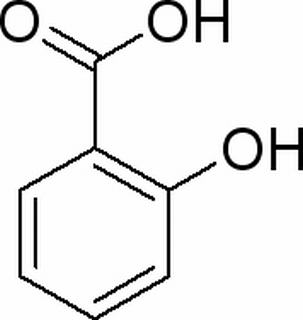Home
Products
Salicylic acid



| Product Name | Salicylic acid |
| Price: | $15 / 50mg |
| Catalog No.: | CN03447 |
| CAS No.: | 69-72-7 |
| Molecular Formula: | C7H6O3 |
| Molecular Weight: | 138.12 g/mol |
| Purity: | >=98% |
| Type of Compound: | Phenols |
| Physical Desc.: | Powder |
| Source: | The herbs of Myrica rubra |
| Solvent: | Chloroform, Dichloromethane, Ethyl Acetate, DMSO, Acetone, etc. |
| SMILES: |
| Contact us | |
|---|---|
| First Name: | |
| Last Name: | |
| E-mail: | |
| Question: | |
| Description | Salicylic acid inhibits cyclo-oxygenase-2 (COX-2) activity independently of transcription factor (NF-κB) activation. |
| Target | COX-2 Autophagy Mitophagy |
| In Vitro | Salicylic acid is an effective inhibitor of COX-2 activity at concentrations far below those required to inhibit NF-κB (20 mg/mL) activation. Salicylic acid inhibits prostaglandin E2 release when add together with interleukin 1β for 24 hr with an IC50 value of 5 μg/mL, an effect that is independent of NF-κB activation or COX-2 transcription or translation. Salicylic acid acutely (30 min) also causes a concentration-dependent inhibition of COX-2 activity measured in the presence of 0, 1, or 10 μM exogenous arachidonic acid. In contrast, when exogenous arachidonic acid is increased to 30 μM, Salicylic acid is a very weak inhibitor of COX-2 activity with an IC50 of >100 μg/mL. When added together with IL-1β for 24 hr, Salicylic acid causes a concentration-dependent inhibition of PGE2 release with an apparent IC50 value of approximately 5 μg/mL. The ability of Salicylic acid to directly inhibit COX-2 activity in A549 cells is tested after a 30-min exposure period, followed by the addition of different concentrations of exogenous arachidonic acid (1, 10, and 30 μM). Salicylic acid causes a concentration-dependent inhibition of COX-2 activity in the absence of added arachidonic acid or in the presence of 1 or 10 μM exogenous substrate with an apparent IC50 value of approximately 5 μg/mL. However, when the same experiments are performed using 30 μM arachidonic acid, Salicylic acid is an ineffective inhibitor of COX-2 activity, with an apparent IC50 value of more than 100 μg/mL, and achieves a maximal inhibition of less than 50%[1]. |
| In Vivo | In C57Bl/6 DIO mice, Salicylic acid decreases both fasting and postprandial plasma glucose levels. Furthermore, there is a trend to reduce plasma triglyceride levels after Salicylic acid treatment in C57Bl/6 DIO mice (P=0.059). Salicylic acid significantly reduces 11β-HSD1 mRNA in omental adipose tissue in C57Bl/6 DIO mice, with a similar trend in mesenteric adipose (P=0.057). In mesenteric adipose of C57Bl/6 DIO mice, Salicylic acid also reduces 11β-HSD1 enzyme activity[2]. |
| Cell Assay | To assess the direct effect of Salicylic acid on COX-2 activity after induction has occurred, A549 cells are first treated with IL-1β for 24 hr, and the culture medium is replaced with DMEM containing different concentrations of Salicylic acid(10, 100 and 1000 μg/mL). Cells are incubated at 37°C for 30 min. Arachidonic acid (1-30 μM) is then added for 15 min, and the medium is removed for the measurement of PGE2[1]. |
| Animal Admin | Mice[2] Adult male C57Bl/6 mice are at age 12 weeks. Diet-induced obese C57Bl/6 mice (C57Bl/6 DIO) are given 10 weeks of high-fat diet (58% fat, 12% sucrose) before treatment. Salicylic acid (120 mg/kg/day) is administered from 1 week after arriving (C57Bl/6 Lean), after 10 weeks of high-fat feeding (C57Bl/6 DIO), or after achieving target weight (HSD1KO-DIO) for 4 weeks to groups of n=8 via osmotic minipumps implant subcutaneously between the scapulae. |
| Density | 1.44 |
| Boiling Point | 211 ºC (20 mmHg) |
| Flash Point | 157 ºC |
| Exact Mass | 138.031693 |
| PSA | 57.53000 |
| LogP | 2.06 |
| Vapour Pressure | 0.0±0.7 mmHg at 25°C |
| Storage condition | Store at RT. |